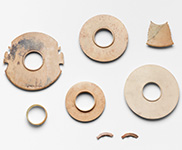Agnes E. Meyer
Individual
1887-1970
American
Constituent Alternate Name(s)
Agnes Elizabeth Ernst
Relations
Child: Mrs. Ruth Meyer Epstein, Katharine Meyer Graham, Elizabeth Meyer Lorentz
Place of activity: New York, New York, United States; Washington, DC, United States; Mt. Kisco, New York, United States;
The daughter of German immigrants, Agnes Ernst graduated from Barnard College in New York in 1907 and became one of the first female reporters hired by the New York Sun. While studying at the Sorbonne in Paris, she became friends with Gertrude Stein and Edward Steichen. Her introduction to the modern art movement expanded further when, through her connection with the Sun, she met Alfred Stieglitz, Georgia O'Keeffe, and other avant-garde artists at Stieglitz's Gallery 291 in New York City. She edited and contributed texts and poems to the gallery's publication 291.
In February 1910, Agnes Ernst married the wealthy financier Eugene Meyer (1875--1959), with whom she had five children. They shared an avid interest in collecting Asian art, sparked by her life-changing introduction to Chinese painting at an exhibition held at the British Museum in 1909. The couple's friendship with collector Charles Lang Freer (1854--1919) led to numerous acquisitions, purchased independently or jointly, that are now part of the Freer Gallery of Art.
Meyer was deeply interested in social conditions, public education, and philanthropic activities. In addition to writing four books, she contributed a series of articles on social conditions in Great Britain during the blitz of World War II. (The series appeared in the Washington Post, the newspaper her husband had purchased in 1933.) Other articles criticized the Works Progress Administration and the government's failure to meet the basic needs of its citizens. During her long life she effectively lobbied for racial integration, federal aid to education, and the creation of the Department of Health, Education and Welfare. Founded in 1944, the Eugene and Agnes E. Meyer Foundation still works to address community issues in the Greater Washington region.
In a series of bequests made in the last decade of her life, Meyer donated to the Freer Gallery of Art the collection that she and her husband had amassed, including ancient Chinese paintings, sculpture, ceramics, metalwork, jade, and calligraphy, Japanese painting and prints, and Buddhist sculpture. Their contributions marked the largest expansion of the Gallery's collection since Freer's gift to the nation in 1919.
Literature
S. C. Bosch-Reitz, Catalogue of an Exhibition of Early Chinese Pottery and Sculpture (New York, 1916).
Writings by Meyer:
Chinese Painting: As Reflected in the Thought and Art of Li Lung-Mein, 1070--1106 (New York, 1923).
Out of These Roots: The Autobiography of an American Woman (Boston, 1953).
Charles Lang Freer and His Gallery (Washington, DC, 1970).
Elsie Carper, "Agnes E. Meyer: Writer, Critic, Champion of Reform," Washington Post (September 2, 1970).
Henry Allen, "Meyer Collection: A Legacy, A Gift," Washington Post (September 27, 1971).
Douglas K. S. Hyland, "Agnes Ernst Meyer, Patron of American Modernism," American Art Journal 12, no. 1 (1980), pp. 64--81.
Warren I. Cohen, East Asian Art and American Culture: A Study in International Relations (New York, 1992).
Thomas Lawton and Linda Merrill, Freer: A Legacy of Art (Washington, DC, 1993).
Katharine Graham, Personal History (New York, 1997).
Dorota Chudzicka, "In Love at First Sight Completely, Hopelessly, and Forever with Chinese Art: The Eugene and Agnes Meyer Collection of Chinese Art at the Freer Gallery of Art," Collections: A Journal for Museum and Archive Professionals 10, no. 3 (Summer 2014), pp. 331--40.
For documentation about Eugene and Agnes Meyer, search the Charles Lang Freer Papers; see http://siarchives.si.edu/collections/siris_arc_238779 and http://www.asia.si.edu/archives/finding_aids/Freer.html
For more on Agnes Meyer, see http://www.gwu.edu/~erpapers/mep/displaydoc.cfm?docid=erpn-agnmey and http://research.frick.org/directoryweb/browserecord.php?-action=browse&-recid=7293pr

